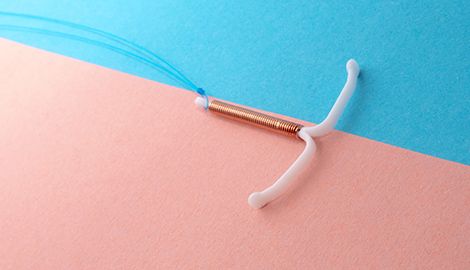Five Things to Consider when Picking a Birth Control Method

Birth control gives you or your partner the tools to decide if and when you become pregnant. There are a lot of options to choose from, so we’ve broken down five key things to consider when picking a birth control method for you.
1. How Effective is it?
Not all birth control methods work in the same way or work as well as each other. Below we've listed them from most effective to least effective.
Most Effective (Low Maintenance):
Implant: The implant (Nexplanon®) is a tiny plastic rod that is inserted under the skin of the upper arm. It lasts up to 3 years and is 99% effective against pregnancy. It can be removed at any time.
IUD: Hormonal IUDs (Mirena®, Skyla®, Kyleena®, & Liletta®) can last anywhere from 3 – 6 years, depending on which kind you select. These tiny t-shaped plastic devices are inserted through the cervix and into the uterus by a trained medical provider. The Copper IUD (Paragard®) is a tiny t-shaped device wrapped in copper. It naturally repels sperm and is effective for up to 10 years, making it a long-term hormone-free option. The copper IUD is 99% effective and can also be removed at any time. The IUD can be removed at any time by a medical provider via the attached strings. Anyone can get an IUD, even if they haven't had a child yet.
Sterilization: Both men and women can be sterilized, which is a form of permanent contraception. This usually occurs as a surgery on the reproductive organs and is up to 99% effective. Sterilization should only be considered if you are absolutely certain that you do not want any additional children, as it may be painful, expensive, and even impossible to reverse.
Abstinence: Abstinence means not engaging in any kind of sex, including oral, vaginal or anal. Not having sex is the only 100% way to prevent pregnancy.
Moderately Effective (Use on a Schedule):
Pill: The birth control pill is taken at the same time every day. There are several kinds of pills with different hormone doses and combinations. They typically come in 28-day packs (mirroring a 28-day menstrual cycle). These pills are taken for 21 days, followed by 7 days of placebo pills, when you will have a period, and then a new pack is started. Other kinds of pills are taken in other ways, to be sure to talk to your healthcare provider. If you are having side effects on the pill, trying a different kind might help. The pill is about 93% effective when used consistently and correctly.
Ring: The birth control ring (NuvaRing®, Annovera®) is a flexible, latex-free plastic ring that's placed in the vagina. It contains the hormones that are released over a three-week period. The ring is removed for the fourth week, allowing a period to occur, then a new ring is inserted after 7 days. The ring is 93% effective when used consistently and correctly.
Patch:The birth control patch (Twirla® or Xulane®) is a small, sticky square that’s worn on an arm, back, lower belly, or other fleshy places on the body. It’s worn for three weeks at a time, then removed for the fourth week, when a period occurs. A new patch is placed after 7 days. The patch is 93% effective when used consistently and correctly.
Shot: The birth control shot (Depo-Provera®) is an injection (shot) of the hormone progestin given by a healthcare provider. It’s given once every 3 months. The shot is 96% effective when used consistently and correctly.
Less Effective (Use Every Time):
Condoms: Condoms are one-time use latex or plastic (polyurethane) sheaths worn over a penis or in the vagina to catch semen. Condoms can tear or be put on incorrectly, making them 79% (internal condoms) to 87% (external condoms) effective when used consistently and correctly, but they are also the only method that protects against both pregnancy and STIs.
Diaphragm: The diaphragm (Caya®) is a dome-shaped cup made of silicone with a flexible rim. It is self-inserted into the vagina and covers the cervix, creating a barrier to block the sperm from the egg. It is best used with spermicide and is 83% effective when used consistently and correctly.
Cervical Cap: The cervical cap (FemCap™) is silicone cap that is inserted into the vagina and covers the cervix. creating a barrier to block the sperm from the egg. It is best used with spermicide and is 83% effective when used consistently and correctly, depending on whether you’ve previously given birth vaginally.
Contraceptive Sponge: The contraceptive sponge (Today®) is a small, round, soft sponge that covers the cervix before sex. The sponge contains spermicide, and must be kept in place for 6 hours after sex, and can stay there for up to 24 hours. When used consistently and correctly, the sponge is 83% effective for someone who has not has not given birth vaginally, and 76% effective for someone who has given birth vaginally.
Fertility-Awareness Methods: There are various ways to track fertility, all of which aim to keep sperm out of the uterus near ovulation, when the egg is released. These include the temperature, cervical mucus, and calendar methods. They aren’t considered to be highly effective methods because they require so much tracking, as well as a regular menstrual cycle.
Withdrawal: The withdrawal method, more commonly known as the ‘pull out’ method, refers to removing the penis from the vagina before ejaculation occurs. Withdrawal requires a high level of body awareness and control in order for it to work. There’s also a risk of pregnancy due to pre-ejaculate (pre-cum), which can contain sperm and lead to pregnancy.
A Note on Effectiveness
All of the methods listed above can have their effectiveness reduced if they are not used consistently and correctly. For condoms, that means wearing it over the penis for the entire duration of sexual intercourse, and using a new condom every time you have sex. For pills, that means taking it at the same time every day, and not skipping any days. Anytime a birth control method is used incorrectly, or if you don't use it every time, it will be less effective.
2. How easy is it to use?
All birth control methods are user-friendly, so it’s up to you to decide which method fits best into your lifestyle and habits. For example, once an IUD or implant is inserted, you’ll only have to think about it again is when it’s time to remove or replace it. This is a great option for those who might not remember to use a birth control method every day, week, or month. On the other hand, the pill can be stopped at any time, without having to make an appointment with a medical provider, giving you full control over switching or stopping use.
3. Do I prefer hormones or hormone-free?
Although hormone-based birth control options are safe for short and long-term use, lots of people opt for hormone-free options. The copper IUD is a favorable choice, especially given its long-lasting effectiveness. Both internal and external condoms are hormone-free options. They also provide STI protection and can be used at the same time as many other birth control methods. The diaphragm and the cervical cap are hormone-free methods that, when combined with spermicide, can be up to 83% effective against pregnancy when used consistently and correctly.
4. How does it impact menstruation?
Most hormonal birth control methods will impact your menstrual cycle. This means your periods could be shorter, lighter, or go away altogether. That’s why some people start birth control – to help with menstrual pain. Hormone-free options don’t typically have an impact on periods. Talk to your provider about how your method of choice may impact your menstrual cycle.
5. How much does it cost?
Most birth control methods are affordable or even free! Many clinics can provide birth control to those without health insurance. For those with insurance, most companies completely cover birth control. Condoms can be an expense, but many organizations provide them to young people for free. Overall, the cost of birth control is still much cheaper than pregnancy and a new baby.
Helpful Resources
- Planned Parenthood: This is a nationwide network of health centers that offers affordable sexual reproductive services and resources such as, STI testing, birth control, and free condoms.
- Bedsider: Bedsider is an online birth control support network for women 18-29 operated by Power to Decide, the campaign to prevent unplanned pregnancy.
- Title X: These clinics are federally funded to provide low-to-no cost reproductive health care, including STI testing and contraception.
